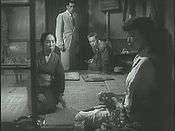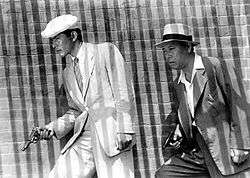Stray Dog (film)
| Stray Dog | |
|---|---|
 | |
| Directed by | Akira Kurosawa |
| Produced by | Sōjirō Motoki |
| Written by |
Akira Kurosawa Ryūzō Kikushima |
| Starring |
Toshiro Mifune Takashi Shimura |
| Music by | Fumio Hayasaka |
| Cinematography | Asakazu Nakai |
| Edited by |
Toshio Gotō Yoshi Sugihara |
Production company | |
| Distributed by | Toho |
Release dates |
|
Running time | 122 minutes |
| Country | Japan |
| Language | Japanese |
Stray Dog (野良犬 Nora Inu) is a 1949 Japanese police procedural film noir directed by Akira Kurosawa and starring Toshiro Mifune and Takashi Shimura. The film is considered a precursor to the contemporary police procedural and buddy cop film genres.[1]
Plot
The film takes place during a heatwave in post-war Tokyo. Rookie homicide detective Murakami (Toshiro Mifune) has his Colt pistol stolen during a trolley ride. He chases the pickpocket, but loses him. Filled with shame, he reports the theft at headquarters. He prowls the city backstreets undercover for days, looking for suspects and picking up leads. He eventually picks up the trail of a gun racket.
When the stolen gun is used in a crime, Murakami partners up with the veteran detective Satō (Takashi Shimura). After questioning a suspect, Satō and Murakami end up at a baseball game looking for a gun dealer named Honda. He points them to Yusa, a disenchanted war veteran who has resorted to crime. They investigate Yusa's sister's house and his sweetheart, showgirl Harumi Namiki (Keiko Awaji), to no avail.

Murakami's gun is used again, this time as a murder weapon. They question Namiki at her mother's house. She is still reticent to talk, so Satō leaves to investigate Yusa's trail, while Murakami remains behind. Satō comes across Yusa's last hideout. He places a call for Murakami, but, just as he is about to reveal Yusa's location, the criminal makes a run for it. Satō gives chase, but is shot in the rain and left for dead. A desperate Murakami arrives soon enough to donate blood to his friend at the hospital.
The following morning, Namiki has a change of heart and informs Murakami at the hospital that she had an appointment with Yusa at a train station nearby. Murakami races to the meeting and deduces who Yusa is from his mud spattered clothing. He pursues his quarry into a forest and is wounded in the arm, but manages to take Yusa into custody. Back at the hospital, Satō has recovered and congratulates Murakami on his first citation. Murakami reflects on Yusa's plight and on the parallels between him and the criminal. Satō tells him to forget about Yusa and get ready for the cases he will solve in the future.
Cast
- Toshiro Mifune as Detective Murakami
- Takashi Shimura as Detective Satō
- Keiko Awaji as Harumi Namiki
- Eiko Miyoshi as Harumi's mother
- Noriko Honma as Wooden Tub Shop woman
- Isao Kimura as Yusa
- Minoru Chiaki as Girlie Show director
- Ichiro Sugai as Yayoi Hotel owner
- Gen Shimizu as Police Inspector Nakajima
- Noriko Sengoku as Girl
Production

Kurosawa mentioned in several interviews that his script was inspired by Jules Dassin’s The Naked City and the works of Georges Simenon.[2] Kurosawa wrote the script with Ryūzō Kikushima, a writer who had never written a script before.
During the opening credits, there is footage of a panting dog. However, when American censors saw the footage, they assumed that the dog had been harmed. This run-in with American censors caused Kurosawa to remark that this was the only time he wished Japan had not lost World War II.[3] The film released in the U.S in 1963.
Despite being one of Akira Kurosawa's most critically renowned postwar films, Nora Inu was once not held in such high regard by the director himself. Kurosawa initially said that he thought little of the film, calling it "too technical" and also remarking that it contains "all that technique and not one real thought in it." His attitude had changed by 1982, when he wrote in his autobiography that "no shooting ever went as smoothly," and that "the excellent pace of the shooting and the good feeling of the crew can be sensed in the finished film."[4]
Remake
The film was remade in 1973 as Nora Inu, starring Tetsuya Watari as Murakami and Shinsuke Ashida as Satō. The location was changed from Tokyo to Okinawa.[3] It was remade for television in 2013.[5]
Awards
At the 1950 Mainichi Film Concours it won awards for Best Actor (Takashi Shimura), Best Film Score (Fumio Hayasaka), Best Cinematography (Asakazu Nakai) and Best Art Direction (Sō Matsuyama).

References
- ↑ "FilmInt". Film International. Sweden: Kulturrådet. 4 (1-6): 163. 2006. Retrieved 28 April 2012.
In addition to being a masterful precursor to the buddy cop movies and police procedurals popular today, Stray Dog is also a complex genre film that examines the plight of soldiers returning home to post-war Japan.
- ↑ "DVD Review of Stray Dog by Gary Morris". imagesjournal.com. Retrieved 2011-10-12.
- 1 2 "Stray Dog: Trivia". IMBd. Retrieved 16 December 2013.
- ↑ "Stray Dog: Kurosawa Comes of Age". criterion.com. Retrieved 2011-10-12.
- ↑ "Nora Inu". Archived from the original on January 14, 2013.
External links
| Wikimedia Commons has media related to Stray Dog. |
- Stray Dog at the Internet Movie Database
- Stray Dog at AllMovie
- Criterion Collection essay by Chris Fujiwara
- Stray Dog (Japanese) at the Japanese Movie Database
